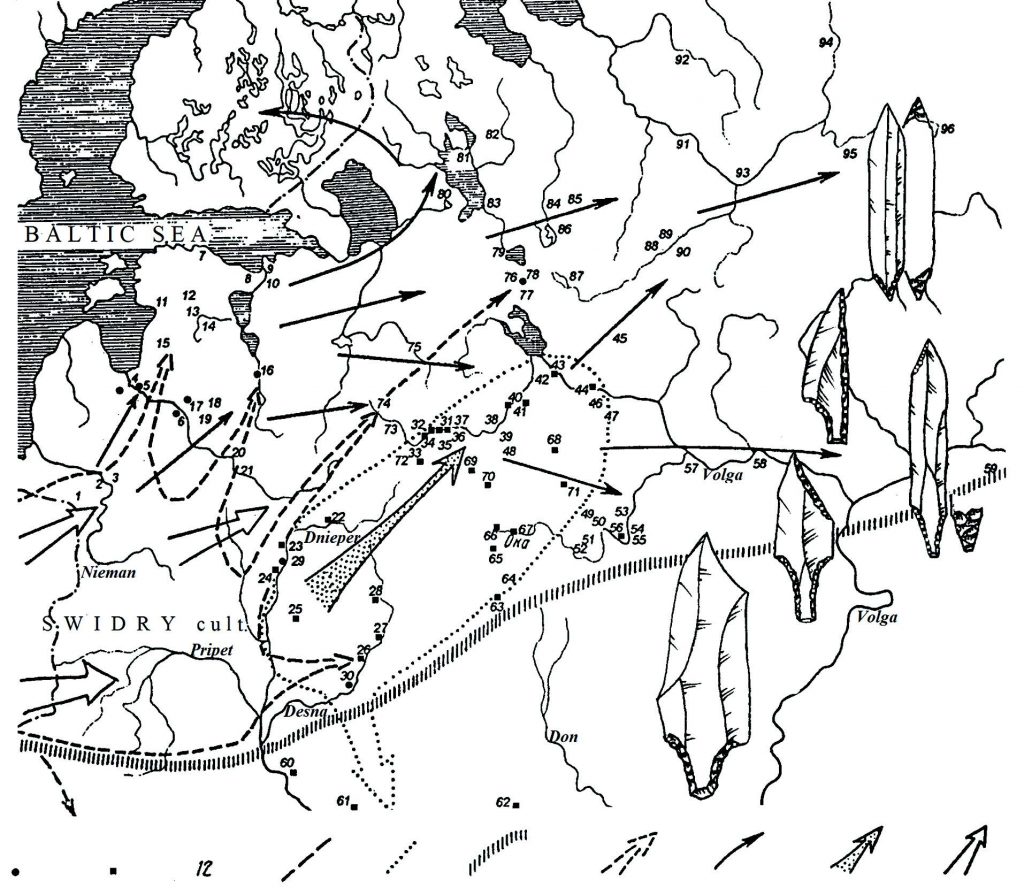New article by Leonid Zaliznyak, Mesolithic origins of the first Indo-European cultures in Europe according to the archaeological data (also available in Russian).
The article refers to the common Meso-Neolithic basis of Ukrainian ancient Indo-European cultures (Mariupol, Serednii Stih) and Central Europe (Funnel Beaker and Globular Amphorae cultures) of the fourth millennium BC. Archaeological materials show that the common cultural and genetic substrate of the earliest Indo-Europeans in Europe was forming from the sixth to the fourth millennia BC due to migration of the Western Baltic Mesolithic population to the east through Poland and Polissia to the Dnipro River middle region and further to the Siverskyi Donets River.
I already spoke about the view of the Russian school, and its interpretation of the origin of Proto-Indo-European (and potentially Indo-Uralic) in North-Eastern European Mesolithic. While the genetic interpretation seemed quite off in Klejn’s last article discussing Genetics, Zaliznyak improves the archaeological model to some extent.
This model is partially compatible with the expansion of R1b lineages and the Villabruna cluster with migrating peoples of post-Swiderian cultures into eastern Europe. However – as seems to be often the case with linguists of post-Soviet countries (maybe because of the greater influence of Nostraticists there) – proto-language dates are pushed further back in time than is warranted by usual guesstimates, and thus the model is way off as it approaches the Neolithic, and especially beyond that time.
As you can see, a Post-Swiderian expansion of (a language ancestral to) Proto-Indo-European (e.g. Pre-Indo-Uralic) is compatible with the Indo-European demic diffusion model. On the other hand, it is very difficult to assert anything about that period in terms of language change or evolution, because of scarce and obscured archaeological finds, and because of different admixture waves found in east Europe (in the Pontic-Caspian steppe, forest-steppe, and Forest Zone) during the Palaeolithic-Mesolithic – and even during the Mesolithic-Neolithic – transition.
It is therefore impossible today to ascertain if it was a community of western (R1b) or eastern (R1a) Eurasian lineages who spread Pre-Indo-Uralic; or which combination of WHG:ANE (if any) might have yielded EHG ancestry (and thus how a Pre-Indo-Uralic language might have developed from the influence of west and east Eurasian communities); or how later waves of ANE and CHG ancestry found in steppe populations (during the Neolithic) might have brought cultural change to the communities, or even if they accompanied the more recent R1a-M417 subclades (or haplogroup Q) found in the region…

This Russian (or post-Soviet, or East European) school of thought, which is mainly based on their traditional archaeological models, tries to use new genetic data to obtain plausible archaeological-linguistic models of Indo-European expansion. Nevertheless, this improved model is likely to cause some quick dismissals and be made fun of by certain amateur geneticists.
It is curious, though, that some people are quick to judge archaeologists trying to fit new data to their traditional models – which seems like the right way of obtaining sound models for prehistoric human migrations -, but are on the other hand extremely confident about any new model based solely on genetics and their personal desires: very strong confirmation (and rejection) bias at play, indeed.
For example, how could Sredni Stog be Late Indo-European-speaking, if the best candidate for a Late Indo-European-speaking community (the Yamna culture) is almost fully unrelated? For some, simply because of the ‘Yamnaya ancestral component’.
In spite of many naysayers – amateur geneticists who hate archaeological models not fitting their dreams – , it seems that otherwise extremely disparate Indo-European schools of thought (like the German, American, and Spanish schools, the British, and even Leiden, the French, and to some extent the East European school) are converging in Linguistics, while in Archaeology Heyd’s model of Yamna migration (independent of the Corded Ware culture) is being accepted as mainstream with help from aDNA analysis – now also partially by Anthony, at last.
Only researchers of a single workgroup (very popular today, it seems) – tend to diverge from the general unifying trend, following mostly their interpretations of new genetic papers in a funny vicious circle, that is creating a growing bubble of misinformation with no substantive basis (apart from the controversial existence of a Kurgan people).
Let’s see how this ends up, if new genetic algorithms can truly revolutionise Archaeology and Linguistics, or if academic models will keep proving right over misinterpretations from recent genetic papers…
Featured image, from the article, “The settling of the early Indo-Europeans in the period from the 4th to the 2nd millennia BC”.
Related:
- The new “Indo-European Corded Ware Theory” of David Anthony
- Something is very wrong with models based on the so-called ‘steppe admixture’ – and archaeologists are catching up
- The renewed ‘Kurgan model’ of Kristian Kristiansen and the Danish school: “The Indo-European Corded Ware Theory”
- Correlation does not mean causation: the damage of the ‘Yamnaya ancestral component’, and the ‘Future America’ hypothesis
- New Ukraine Eneolithic sample from late Sredni Stog, near homeland of the Corded Ware culture
- Germanic–Balto-Slavic and Satem (‘Indo-Slavonic’) dialect revisionism by amateur geneticists, or why R1a lineages *must* have spoken Proto-Indo-European